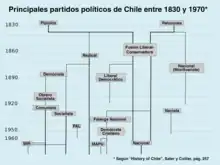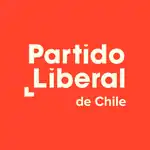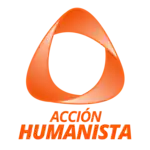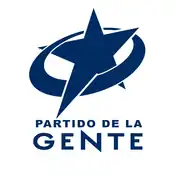List of political parties in Chile
The political parties of Chile are three clearly categorized, distinct, political groups: the left-wing, the center and the right-wing. Before the 1973 coup, these three political groups were moderately pluralistic and fragmented.
This distinction has existed since the end of the 19th century. Since then, the three groups have been made up of different parties. Each party has had some amount of power in the management of the State or has been represented in the National Congress.
Political parties are recognized legally and formally by Political Constitution of the Republic of Chile of 1980 and by the Organic Constitutional Law of Political Parties of 1987 as organizations that participate in the legal political system and contribute to guiding public opinion.
History of Chile's political parties
.svg.png.webp) |
|---|
|
|
Origins and the first blocks (1810–1860)

In Chile, the first political groups were created during the Independence of Chile: the Royalists and the Patriots. The Royalists wanted to maintain the status quo with the King of Spain, while the Patriots wanted to gain a larger degree of freedom. In turn, the Patriots further split into the Moderates, who wanted a slow pace of reform, and the Radicals or Extremists, who favored a much faster pace. All of the early political groups were shy of advocating for full independence since it was unknown if the King would regain his power from Napoleon.
Once Chile gained independence, many political groupings emerged. They were based on various popular leaders during that time, instead of common political ideas. Two very strong political groupings were the Pipolos (liberals) and the Pelucónes (conservatives). Two minor parties, the O’Higginists and the Tobacconists, were often on the Pelucónes' side. After Diego Portales Palazuelos became the architect of the New Institution and the Constitution of 1833, the Pelucónes prevailed for thirty years (1831–1861).
From 1831 to 1861, the prevailing political system was one in which the President co-opted a successor. This system greatly influenced the idea that power should be transferred between members of the ruling political faction. It was only the "Question of the Sacristan" (1856), which divided The Pelucónes, allowed for the rise of the Liberals to power in 1861.
Dominance of the traditional parties (1860–1920)
The formal emergence of political parties in Chilean institutions occurred around the 1850s. Chileans began to challenge the President as the leading role in national political life through the National Congress. In 1891, the disagreement was resolved after a Civil War, in favor of a parliamentary system.
Around that time, the rise of the middle class would eventually lead to the creation of the Radical Party. Their campaign started in the 1850s, as a group defending the interests of the silver mine owners, but it would gradually shift its focus to the employees of the growing state bureaucracy. Soon afterwards, from the same branch of radicalism, the Democratic Party appeared. It was a community that was born closer to the working class segment of society, but that over time would join the game of alliances within the rest of the party system.
After the Chilean Civil War of 1891, the political system began to embody elements of a parliamentary system. Hence, the political coalitions became very strong. Although around twenty distinct political parties and movements existed, Chilean politics was structured around two large groups: the Liberal Alliance (of Liberal and Progressive tendency) and the Coalition (Conservative, Catholics). At the same time, political parties, formerly tools of the upper-class, expanded to include the thriving middle and working classes too.
Expansion of political parties (1920–1973)
With the rise of immigration from Europe, workers with anarchist and socialist ideas came to Chile. Additionally, in the mid-19 century, the union movement began in the nitrate fields of the north of Chile through a surge of the joint labor unions. It is from these processes that in 1912, the Workers' Socialist Party was founded in Iquique by the typographer Luis Emilio Recabarren and 30 union workers and employees. The Workers' Socialist Party is defined as the political party of the Chilean working class. In 1922, the party joined the Third Communist International. Since that date, the party has been known as the Communist Party of Chile.
In the period between 1920 and 1938 (between the start of the first presidential term of Arturo Alessandri Palma and the end of his second term) a series of political incidents led to the loss of the importance of traditional nineteenth-century parties, but for the benefit of the "party masses".
The splendor of this new type of political party would come with the three presidential terms of the Radical Party between 1938 and 1952. At that time, the Radical Party (the faction of the middle class, par excellence), transformed into a large body of positions and political favors, which in the long run would lead to its discredit. Its place as an intermediate political group—between the right and the left—would be taken by the Christian Democratic Party. The Christian Democratic Party is the successor of the National Falange, which in turn had split from the declining Conservative Party after the victory of Eduardo Frei Montalva (1964–1970). Regarding political parties, their main characteristic between 1938 and 1973 was their structuring into the classic "three-thirds" system (right, center, and left).
With Salvador Allende, the Popular Unity came to power as a vast political coalition composed of elements from the center and the left. However, the Military Coup of 1973 signified not only the disappearance of the Popular Unity, but the breakdown of the party system and its end during most of the dictatorship of Augusto Pinochet. Only in the last year of the military dictatorship was the Organic Constitutional Law of Political Parties enacted, which regulated their formation and function.
Proscription of parties and reorganization (1973–1990)
Between 1973 and 1987, Chilean political parties were prohibited. On October 8, 1973, the members of the Popular Unity were banned and three days later, the rest of the political parties and movements were declared adjourned,[1] and definitively dissolved on March 12, 1977.[2]
On October 1, 1996, the Organic Constitutional Law was published in the Legal Gazette, which re-established the system of electoral registrations and created the Electoral Service of Chile (Servel) as a replacement for the former Directorate of the Electoral Registry.[3] On March 23, 1987, the Organic Constitutional Law of Political Parties was published—which established its objectives, requirements for legalization and the internal organization between others—with which the groups began procedures for their legal recognition.[4]
The National Party was the first political organization to be legally recognized by the Servel on December 23, 1987, inscribed officially in the registry on January 4, 1988.[5] In the following months—before the Plebiscite of October 5, 1988—the National Advance, Humanist, National Renewal, Radical Democracy, Socialist, Christian Democratic (CDP), Party for Democracy, Party of the South, Radical and Green parties were legalized.[6]
Return to democracy (1990–2022)
With the restoration of Democracy in 1990, the prominent political coalition was the Concertación de Partidos por la Democracia (Coalition of Parties for Democracy), a center-left group initially founded by 17 parties, of which the most important, which remained in the coalition throughout the years, were: The Christian Democratic Party, the Socialist Party, the Party for Democracy and the Radical Party. The "Concertación" governed Chile throughout the presidencies of Patricio Aylwin (1990–1994), Eduardo Frei Ruiz-Tagle (1994–2000), Ricardo Lagos (2000–2006) and Michelle Bachelet (2006–2010). The opponent of the ruling coalition, was the Alianza (Alliance). The Alliance was a group of center-right parties, formed by the main parties that supported the "YES" option in the 1988 plebiscite. Extra-parliamentarily, there was the leftist coalition Juntos Podemos Más (Together we can do more), formed by the Communist Party, Humanist Party, PC-AP and others left-wing movements, this coalition did not achieve great electoral results due to the binomial system, which favoured the Concertacion and the alliance.
The "Alliance" came to power when Sebastián Piñera (2010–2014) assumed office. In 2013, after electoral losses, the "Concertación", with the intention of renewing its image, decided to make an agreement with the Communist Party, the Citizen Left, and the MAS Region, creating the New Majority. This coalition won comfortable victories in the 2013 elections and achieved re-election of Michelle Bachelet between 2014 and 2018. In turn, the parties that made up the Alliance, regrouped in 2015 in a new coalition denominated Chile Vamos (Let's go Chile).
In 2016, the number of political parties in Chile doubled, increasing from 14 to 32. It came as a precursor to the municipal elections of the year and the Parliamentary Elections of 2017,[7] given that they will be the first to be held under the new proportional electoral system, the replacement for the binomial system. The binomial system favoured the existence of two blocks to the detriment of isolated parties and independent candidates. In that election, the Frente Amplio (Broad Font) appeared, a coalition that brought together left-wing sectors, which surprisingly won the election of 20 deputies.[8] In the presidential election, Sebastián Piñera was able to return to the government and establish Chile Vamos (Let's go Chile) as an official coalition between 2018 and 2022.
Constitutional Convention and reorganization of coalitions (2022–present)
After the social outburst of 2019, a plebiscite was held that defined the drafting of a new constitution through a Constitutional Convention. The members of that body were elected in May 2021, in a process that benefited independents over political party militants. The most successful group of independents was The List of the People.
From that election, the coalition Apruebo Dignidad (I Approve Dignity) emerged, which gathered the coalitions Frente Amplio (Broad Front) and Chile Digno (Worthy Chile). This group supported the presidential candidacy of Gabriel Boric, who after winning in the ballot decided to summon the Socialist, For Democracy, Radical and Liberal parties to the government, which were grouped in a coalition called Democratic Socialism. This implied the definitive break of the former Concertación/New Majority with the Christian Democratic Party, which was not invited to the new administration.
From the right-wing emerged the Republican Party, which in the parliamentary elections achieved the election of 14 deputies and one senator, facing the traditional center-right grouped in Chile Vamos, which from 2022 went to the opposition after the end of Piñera's government. Other blocks also emerged in those elections, such as the conservative liberal Partido de la gente (Party of the people).
Political parties
This article lists political parties in Chile. Chile has a multi-party system.
Active
As of October 2023 there are 25 legally constituted political parties in Chile.[9]
| Party/Alliance | Abbr. | Est. | Position | International affiliation | Governors[10] | Senators[11] | Deputies[12] | Regional advisors[13] | Mayors[14] | Councilors | |||
|---|---|---|---|---|---|---|---|---|---|---|---|---|---|
| Let's go Chile Chile Vamos |
ChV | 2015 | Centre-right to right-wing | IDU | 0 / 16 |
20 / 50 |
41 / 155 |
107 / 302 |
64 / 345 |
733 / 2,240 | |||
| Independent Democratic Union Unión Demócrata Independiente | UDI | 1983 | Right-wing | IDU[15] | 0 / 16 | 9 / 50 | 19 / 155 | 43 / 302 | 32 / 345 | 298 / 2,240 | |||
 |
National Renewal Renovación Nacional |
RN | 1987 | Centre-right to right-wing | IDU,[15] CDI[16] | 0 / 16 | 8 / 50 | 20 / 155 | 53 / 302 | 31 / 345 | 374 / 2,240 | ||
| Political Evolution Evolución Política |
Evópoli | 2012 | Centre-right | LI,[17] RELIAL | 0 / 16 | 3 / 50 | 2 / 155 | 11 / 302 | 1 / 345 | 61 / 2,240 | |||
.svg.png.webp) |
Democratic Socialism Socialismo Democrático |
SD | 2021 | Centre-left | None | 4 / 16 |
10 / 50 |
21 / 155 |
53 / 302 |
52 / 345 |
653 / 2,240 | ||
 |
Socialist Party Partido Socialista de Chile |
PS | 1933 | Centre-left | PA, SI, FSP, COPPPAL |
4 / 16 | 7 / 50 | 12 / 155 | 23 / 302 | 23 / 345 | 272 / 2,240 | ||
| Party for Democracy Partido por la Democracia | PPD | 1987 | Centre-left | PA, SI, COPPPAL |
0 / 16 | 3 / 50 | 3 / 155 | 19 / 302 | 17 / 345 | 202 / 2,240 | |||
| Radical Party[lower-alpha 1] Partido Radical de Chile |
PR | 1863 | centre-left | PA, SI, COPPPAL |
0 / 16 | 0 / 50 | 3 / 155 | 11 / 302 | 11 / 345 | 174 / 2,240 | |||
 |
Liberal Party[lower-alpha 2] Partido Liberal de Chile | PL | 2013 | Centre-left | LI | 0 / 16 | 0 / 50 | 3 / 155 | 0 / 302 | 1 / 345 | 5 / 2,240 | ||
 |
Approve Dignity Apruebo Dignidad |
AD | 2021 | Left-wing to far-left |
None | 0 / 16 |
4 / 50 |
31 / 155 |
52 / 302 |
17 / 345 |
304 / 2,240 | ||
 |
Communist Party Partido Comunista de Chile |
PCCh | 1922 | Left-wing to far-left | FSP, CBP, IMCWP |
0 / 16 | 2 / 50 | 12 / 155 | 21 / 302 | 6 / 345 | 155 / 2,240 | ||
| Democratic Revolution[lower-alpha 3] Revolución Democrática |
RD | 2012 | Centre-left to left-wing | None | 0 / 16 | 1 / 50 | 6 / 155 | 12 / 302 | 6 / 345 | 43 / 2,240 | |||
.png.webp) |
Social Green Regionalist Federation[lower-alpha 4] Federación Regionalista Verde Social |
FREVS | 2017 | Centre-left to left-wing | None | 0 / 16 | 1 / 50 | 1 / 155 | 7 / 302 | 1 / 345 | 47 / 2,240 | ||
| Social Convergence[lower-alpha 5] Convergencia Social | CS | 2019 | Left-wing | PI | 0 / 16 | 0 / 50 | 6 / 155 | 10 / 302 | 4 / 345 | 52 / 2,240 | |||
| Commons[lower-alpha 6] Comunes | Comunes | 2019 | Left-wing | FSP | 0 / 16 | 0 / 50 | 3 / 155 | 0 / 302 | 0 / 345 | 2 / 2,240 | |||
 |
Humanist Action[lower-alpha 7] Acción Humanista |
AH | 2020 | Left-wing | None | 0 / 16 | 0 / 43 | 2 / 155 | 0 / 302 | 0 / 345 | 5 / 2,240 | ||
| Christian Democratic Party Partido Demócrata Cristiano | PDC | 1957 | Centre to centre-left | CDI[16] | 2 / 16 | 3 / 50 | 7 / 155 | 36 / 302 | 46 / 345 | 315 / 2,240 | |||
| Democrats[lower-alpha 8] Demócratas | Demócratas | 2022 | Centre-left to Centre-right | None | 0 / 16 | 2 / 50 | 4 / 155 | 0 / 302 | 0 / 345 | 2 / 2,240 | |||
.svg.png.webp) |
Republican Party Partido Republicano de Chile | PLR | 2019 | Far-right | None | 0 / 16 | 1 / 50 | 11 / 155 | 15 / 302 | 0 / 345 | 11 / 2,240 | ||
 |
Party of the People Partido de la Gente | PDG | 2019 | Centre-right to right-wing | None | 0 / 16 | 0 / 50 | 3 / 155 | 22 / 302 | 0 / 345 | 1 / 2,244 | ||
| Christian Social Party[lower-alpha 9] Partido Social Cristiano | PSC | 2022 | Right-wing to Far-right | None | 0 / 16 | 0 / 50 | 2 / 155 | 1 / 302 | 0 / 345 | 4 / 2,244 | |||
| Yellows for Chile[lower-alpha 10] Amarillos por Chile | AxCh | 2022 | Centre-left to Centre-right | None | 0 / 16 | 0 / 50 | 1 / 155 | 1 / 302 | 0 / 345 | 2 / 2,244 | |||
| Humanist Party[lower-alpha 11] Partido Humanista | PH | 1984 | Left-wing | HI, FSP | 0 / 16 | 0 / 50 | 1 / 155 | 0 / 302 | 1 / 345 | 27 / 2,244 | |||
 |
Equality Party[lower-alpha 12] Partido Igualdad | IGUAL | 2009 | Left-wing to Far-left | FSP | 0 / 16 | 0 / 50 | 0 / 155 | 3 / 302 | 1 / 345 | 25 / 2,244 | ||
 |
People's Party[lower-alpha 13] Partido Popular | Popular | 2022 | Left-wing | None | 0 / 16 | 0 / 50 | 0 / 155 | 1 / 302 | 1 / 345 | 4 / 2,244 | ||
| Popular Green Alliance Party[lower-alpha 14] Partido Alianza Verde Popular | PAVP | 2022 | Centre-left | None | 0 / 16 | 0 / 50 | 1 / 155 | 0 / 302 | 1 / 345 | 0 / 2,244 | |||
| Progressive Homeland[lower-alpha 15] Patria Progresista | PP | 2022 | Centre-left to left-wing | None | 0 / 16 | 0 / 50 | 0 / 155 | 0 / 302 | 0 / 345 | 0 / 2,244 | |||
| Common Sense[lower-alpha 16] Sentido Común | SC | 2022 | Centre to Centre-right | None | 0 / 16 | 0 / 50 | 0 / 155 | 0 / 302 | 0 / 345 | 0 / 2,244 | |||
Historical
- Liberal Party (Partido Liberal) (existed 1849–1966)
- Conservative Party (Partido Conservador) (existed 1851–1949, 1953–1966)
- National Party (Partido Nacional) (existed 1857–1933)
- Democrat Party (Partido Demócrata) (existed 1887–1941)
- Liberal Democratic Party (Partido Liberal Democrático) (existed 1893–1933)
- Democratic Party (Partido Democrático) (existed 1932–1960)
- National Socialist Movement of Chile (Movimiento Nacional Socialista de Chile) (existed 1932–1941)
- Agrarian Labor Party (Partido Agrario Laborista) (existed 1945–1958)
- National Democratic Party (Partido Democrático Nacional) (existed 1960–1999)
- New Democratic Left (founded and dissolved in 1963)
- Socialist Democratic Party (Partido Democrático Socialista) (existed 1964–1965)
- Revolutionary Communist Party (Partido Comunista Revolucionario) (existed 1966–1981)
- National Party (Partido Nacional) (existed 1966–1973, 1983–1994)
- Popular Unitary Action Movement (Movimiento de Acción Popular Unitario or MAPU) (existed 1969–1994)
- Radical Democracy (Democracia Radical) (existed 1969–1990)
- Chilean Social Democracy Party (Partido Socialdemocracia Chilena) (existed 1971–1994)
- Citizen Left (Izquierda Cristiana or Izquierda Ciudadana) (existed 1971–2018)
- National Advance (Avanzada Nacional) (existed 1983–1990)
- Party of the South (Partido del Sur) (existed 1987–1998)
- The Greens (Los Verdes) (existed 1987–1990, 1995–2001)
- Broad Party of Socialist Left (Partido Amplio de Izquierda Socialista or PAIS) (existed 1988–1990)
- Liberal Party (Partido Liberal) (existed 1988–1994)
- Humanist Green Alliance (Alianza Humanista Verde) (existed 1990–1995)
- Union of the Centrist Center (Unión de Centro Centro) (existed 1990–2002)
- National Alliance of Independents (Alianza Nacional de los Independientes) (existed 2001–2006)
- Regionalist Action Party of Chile (Partido de Acción Regionalista de Chile) (existed 2003–2006)
- Independent Regionalist Party (Partido Regionalista Independiente) (existed 2006–2018)
- Broad Social Movement (Movimiento Amplio Social) (existed 2008–2018)
- Progressive Party (Partido Progresista) (existed 2009–2022)
- Amplitude (Amplitud) (existed 2014–2018)
- Citizen Power (Poder Ciudadano) (existed 2015–2019)
- Citizens (Ciudadanos) (existed 2015–2022)
- Common Force (Fuerza Común) (existed 2020–2022)
Alliances
Active
- Chile Vamos, composed of:
- Independent Democratic Union (Unión Demócrata Independiente)
- National Renewal (Renovación Nacional)
- Political Evolution (Evolución Política)
- Government Alliance, composed of:
- Apruebo Dignidad, composed of:
- Democratic Revolution (Revolución Democrática)
- Social Convergence (Convergencia Social)
- Commons (Comunes)
- Communist Party of Chile (Partido Comunista de Chile)
- Social Green Regionalist Federation (Federación Regionalista Verde Social)
- Humanist Action (Acción Humanista)
- Christian Left of Chile (Izquierda Cristiana de Chile)
- Democratic Socialism (Socialismo Democrático), composed of:
- Liberal Party of Chile (Partido Liberal de Chile)
- New Deal (Nuevo Trato)
- Party for Democracy (Partido por la Democracia)
- Radical Party of Chile (Partido Radical de Chile)
- Socialist Party of Chile (Partido Socialista de Chile)
- Apruebo Dignidad, composed of:
Notes and references
- Between 1994 and 2018 it was called the Social Democratic Radical Party for the fusion of the Chilean Social Democracy Party (Partido Socialdemocracia Chilena, founded 1971) and the Radical Party of Chile (Partido Radical de Chile, founded 1863). In 2018 the party regained the name "Radical Party."
- Operates only in AP, TA, AN, VA, RM, BI, and LL.
- Operates in all regions except AP and MA.
- A fusion of Regional and Popular Front, Green North Regional Force, Social Agrarian Regionalist Independent Movement and We Are Aysén parties; operates in all regions except NB, LR, LL, and MA.
- Operates in all regions except AP and AI.
- A fusion of the Poder Ciudadano and Poder Ciudadano del Norte parties; operates in all regions except ML, NB, BI, AR, LR, AI, and MA.
- Operates only in AP, TA and AN.
- Operates only in OH, ML and NB.
- Operates only in AT, OH, NB, BI, AR and LR.
- Operates only in NB, AR, LR and LL.
- Operates only in AP, TA and AN.
- Operates only in AN, AT and CO
- Operates only in AP, TA and AN.
- Operates only in OH, ML and NB.
- Operates only in OH, ML and NB.
- Operates only in AR, LR and LL.
- Ministerio del Interior de Chile (11 October 1973). "Decreto Ley 78" (PDF). www.bcn.cl. Retrieved 11 October 2013.
- Ministerio del Interior de Chile (12 March 1977). "Declara disueltos los partidos políticos, entidades, agrupaciones, facciones o movimientos de carácter político no comprendidos en el Decreto Ley N° 77, de 1973". bcn.cl. Retrieved 17 November 2014.
- Ministerio del Interior de Chile (11 September 1986). "Ley Orgánica Constitucional sobre Sistema de Inscripciones Electorales y Servicio Electoral". LeyChile. Retrieved 23 September 2016.
- Ministerio del Interior de Chile (11 March 1987). "Ley Orgánica Constitucional de los Partidos Políticos". LeyChile. Retrieved 23 September 2016.
- Servicio Electoral (23 December 1987). "Inscribe al Partido Nacional en el Registro de Partidos Políticos". bcn.cl. Retrieved 23 September 2016.
- Servicio Electoral de Chile (2010). "Libro de Partidos Políticos" (PDF). Archived from the original (PDF) on 27 September 2013. Retrieved 29 September 2013.
- ""Explosión" de partidos políticos reconfigura el mapa electoral de cara a 2017". El Mercurio. 3 July 2016. Retrieved 5 July 2016.
- "Frente Amplio llega al Congreso como la gran sorpresa de estas elecciones". 24Horas.cl. 20 November 2017. Retrieved 31 March 2018.
- "Partidos Constituidos". Servicio Electoral (in Spanish). 9 December 2022. Retrieved 9 December 2022.
- "Revisa el listado de gobernadores regionales a lo largo de Chile". www.facebook.com/teletrece. 13 June 2021.
- "Actuales Senadores ordenados alfabéticamente". Senate of Chile (in Spanish). Retrieved 25 January 2021.
- "Partidos Políticos". Chamber of Deputies of Chile (in Spanish). Retrieved 25 January 2021.
- "Archived copy". Archived from the original on 2018-01-30. Retrieved 2020-03-12.
{{cite web}}: CS1 maint: archived copy as title (link) - "El mapa de las elecciones municipales: Cómo se repartieron las comunas del país las fuerzas políticas e independientes". Emol.com. 17 May 2021. Retrieved 25 August 2021.
- "Partidos Miembros".
- "parties". www.idc-cdi.com.
- Web, Editor (2023-05-04). "Evolución Política se incorpora como miembro pleno de la Internacional Liberal". Evópoli (in Spanish). Retrieved 2023-05-12.
{{cite web}}:|first=has generic name (help)
Bibliography
- Cruz-Coke, Ricardo. 1952. Geografía electoral. Santiago de Chile.
- Donoso, Ricardo. 1946. Las ideas políticas en Chile. Fondo de Cultura Económica. México D.F.
- Edwards, Alberto, y Eduardo Frei. 1949. Historia de la los partidos políticos chilenos. Editorial del Pacífico. Santiago de Chile.
- Friedmann, Reinhard. 1988. 1964–1988 La política chilena de la A a la Z. Melquíades. Santiago de Chile. ISBN 956-231-027-1
- Fuentes, Jordi, y Lía Cortés. 1967. Diccionario político de Chile, 1800–1966'. Santiago de Chile
- Gil, Federico G. 1969, El sistema político de Chile. Editorial Andrés Bello. Santiago de Chile.
- Guilisasti Tagle, Sergio. 1964. Partidos políticos chilenos. Editorial Nascimento. Santiago de Chile.
- Kushner, Harvey: Encyclopedia of Terrorism. California: Sage Publications Ltd., 2003.- ISBN 0-7619-2408-6
- León Echaiz, René. 1939. Evolución histórica de los partidos políticos chilenos. Editorial del Pacífico.
- Urzúa Valenzuela, Germán. 1979. Diccionario político institucional de Chile. Editorial Ariete. Santiago de Chile.
- Urzúa Valenzuela, Germán. 1992. Historia política de Chile y su evolución electoral. Desde 1810 a 1992. Editorial Jurídica de Chile. Santiago de Chile. ISBN 956-10-0957-9
.svg.png.webp)